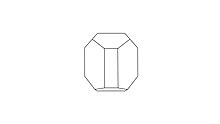User:Chromium2451/Wolframite
| This is the sandbox page where you will draft your initial Wikipedia contribution.
If you're starting a new article, you can develop it here until it's ready to go live. If you're working on improvements to an existing article, copy only one section at a time of the article to this sandbox to work on, and be sure to use an edit summary linking to the article you copied from. Do not copy over the entire article. You can find additional instructions here. Remember to save your work regularly using the "Publish page" button. (It just means 'save'; it will still be in the sandbox.) You can add bold formatting to your additions to differentiate them from existing content. |
Wolframite additions: (i want to add entire new section)
Properties
[edit]The Wolframite Series is mainly formed through magmatic-hydrothermal processes associated with felsic magmas, namely skarns, or through metamorphic processes. In the more common granitic deposits, wolframite minerals can be found in both greisen and veins as its formation is tied to these two structures.[1]
Crystal Structure
[edit]
The wolframite series is comprised of two endmembers, Ferberite (Fe2+ end member), Hübnerite (Mn2+ end member), and Wolframite, (Fe,Mn)WO4 itself being a solid solution between the two endmembers.[2] These two end members can be present in any proportion within Wolframite, from 100% Ferberite to 100% Hübnerite. Wolframite Contains the following percentages of its components, 60.63% W+6 , 9.21% Fe+2 , 9.06% Mn+2 , 21.10% O-2.[3] Wolframite ore exhibits massive form with a dark grey to reddish black coloration.[4] Wolframite in its pure crystal form exhibits a monoclinic crystal system with a perfect cleavage of {010} and an iron black color. Wolframite in its crystalline form also displays lamellar and prismatic habit.[5]
Uses (things i am going to add to existing uses heading)
[edit]
Tungsten salts were used in the 19th century to dye cotton and to make stage costumes which were fire retardant. Additionally in the 19th century tungsten sulfides were sparingly used as lubrication for machining. Wolframite is also used to make tungstic acid which is used in the textile industry.[6]
A major modern day use of tungsten is as a catalyst for various chemical reactions. One such catalytic use of tungsten is as a hydrocracking catalyst which is used to improve the yield of organic components such as gasoline in hydrocarbon refinement as well as reducing harmful pollution and by products. Another catalytic use of tungsten is as a De-NOX catalyst which is used in the treatment of nitrogen oxide emissions to convert harmful nitrogen oxides into inert N2 gas.[6]
Another modern day use of tungsten is as a lubricant. Tungsten disulfide (WS2) is a lubricant with a dynamic coefficient of friction of ~0.03. Tungsten disulfide can be used at temperatures of 583 °C and 1316 °C in air and vacuum respectively. These characteristics allow this lubricant to operate in extreme conditions.[6]
References
[edit]- ^ P., Kwak, T. A. (2014). W-Sn Skarn Deposits : and Related Metamorphic Skarns and Granitoids. Elsevier Science. ISBN 978-0-444-59792-2. OCLC 1044727909.
{{cite book}}: CS1 maint: multiple names: authors list (link) - ^ King, R.J. (2005-03-01). "Minerals explained 41". Geology Today. 21 (1): 33–37. doi:10.1111/j.1365-2451.2005.00493.x. ISSN 0266-6979.
- ^ PIRSSON, LOUIS V.; KNOPF, ADOLPH (November 1947). "Rocks and Rock Minerals". Soil Science. 64 (5): 434. doi:10.1097/00010694-194711000-00020. ISSN 0038-075X.
- ^ Haldar, S. K. (2020). Introduction to mineralogy and petrology. Amsterdam: Elsevier. ISBN 978-0-323-85136-7. OCLC 1181840467.
- ^ "Wolframite Mineral Data". webmineral.com. Retrieved 2023-02-14.
- ^ a b c Christian, J.; Singh Gaur, R.P.; Wolfe, T.; Trasorras, J. R. L. (June 1, 2011). "Tungsten Chemicals and their Applications" (PDF). International Tungsten Industry Association. pp. 1–12. Retrieved February 19, 2023.
